Note: This website was automatically translated, so some terms or nuances may not be completely accurate.
New Discovery via Brainwave Measurement! Radio "Sounds" Affect Emotions
It's said that radio listenership is on the rise lately. With the spread of remote work, many people seem to be listening to the radio while working from home. Haven't you also experienced how having "sound" like radio or music actually helps you concentrate on work or get tasks done more efficiently? What role does sound play in this?
This column delves into the secrets of sound that influence listeners' emotions, based on the results of a joint experiment by Dentsu Media Services / Radio,TV Division and Dentsu ScienceJam Inc., utilizing brainwave measurement technology.
This column is delivered as Web Dentsu Inc. News' first audio article.
▽ Listen to the audio article here
For those who prefer to read the article in text form, we have prepared a written version reconstructed from the audio article below. Please read that version.
▽ Text article here
Kibata: Hello, everyone! I'm Kibata from CXCC Dentsu Lab Tokyo. Sorry for the suddenness. Since we're talking about radio this time, we thought, why not try doing Web Dentsu Inc. in a radio style!

So, everyone, what kind of scene are you listening in today? Working from home? Relaxing at a cafe? Or maybe on the move??
With radiko, listening to radio on PCs or smartphones has become completely commonplace. But with the rise in remote work, radio is getting renewed attention. You can listen while multitasking, and it's perfect as background music. Listener numbers are reportedly on the rise!
This got me wondering: How does radio's defining characteristic—its reliance solely on sound and auditory appeal—impact listeners' emotions? And what kinds of sounds stir those feelings?
To create customer experiences that evoke emotion and build better emotional moments, Dentsu Inc. Media Services / Radio,TV Division and Dentsu ScienceJam Inc. collaborated on an experiment. By measuring brain waves, we visualized the emotional impact radio has on people and what kind of creative content stirs emotions more effectively.
Today, we'll discuss the experiment's results with Satoshi Ogawa and Chihiro Koda from Media Services / Radio,TV Division, and myself, Kihata. First, let's hear from Ogawa-san and Koda-san!
Is Radio Making a Comeback Now?!
Ogawa: I listen to radio regularly, but I'm nervous since I rarely get the chance to actually appear on air. As mentioned earlier, radio has been gaining attention over the past year or two, with more coverage in magazines and elsewhere. Listener numbers are also showing an upward trend.
■radiko User Growth Seen in the Numbers
⇒Comparison of figures before and after COVID-19: January 2020 vs. January 2022
・MAU(※1): 113% increase [from approx. 7.5 million UU(※2) to approx. 8.5 million UU]
・DAU (※3): 128% increase [from approximately 1.4 million UU to approximately 1.8 million UU]
※1 MAU: Abbreviation for Monthly Active Users, indicating the number of active users per month.
※2 UU: Unique Users, indicating the number of users (visitors) who accessed a specific site or app within a given period.
※3 DAU: Stands for Daily Active Users, indicating the number of active users per day.
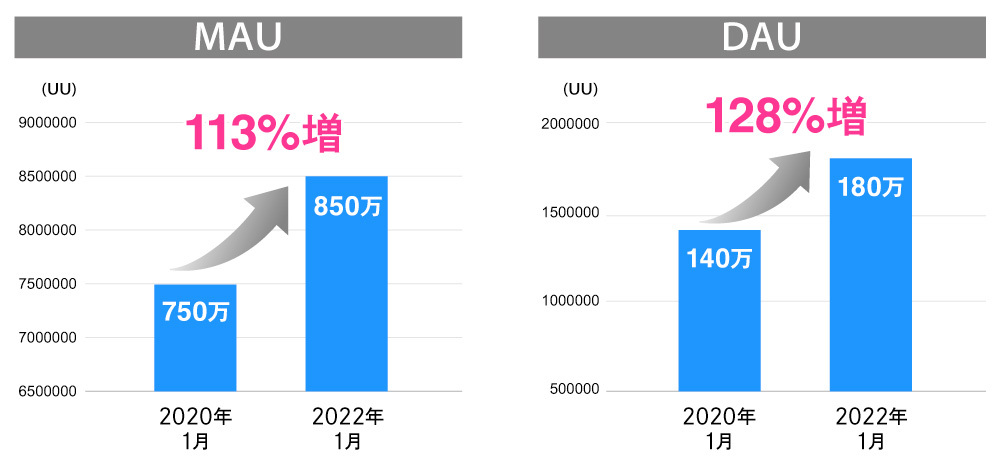
Furthermore, the growth rate of younger users has been particularly high during the COVID-19 pandemic. According to radiko's annual user survey, approximately 55% of users in their teens began listening to radiko after January-June 2020, during the pandemic. Additionally, 20-30% of users aged 20 and above also started listening to radiko after January-June 2020. Thus, the increase in remote environments during the pandemic appears to have heightened the tendency among teens and those in their 20s to listen to radiko and radio programs.
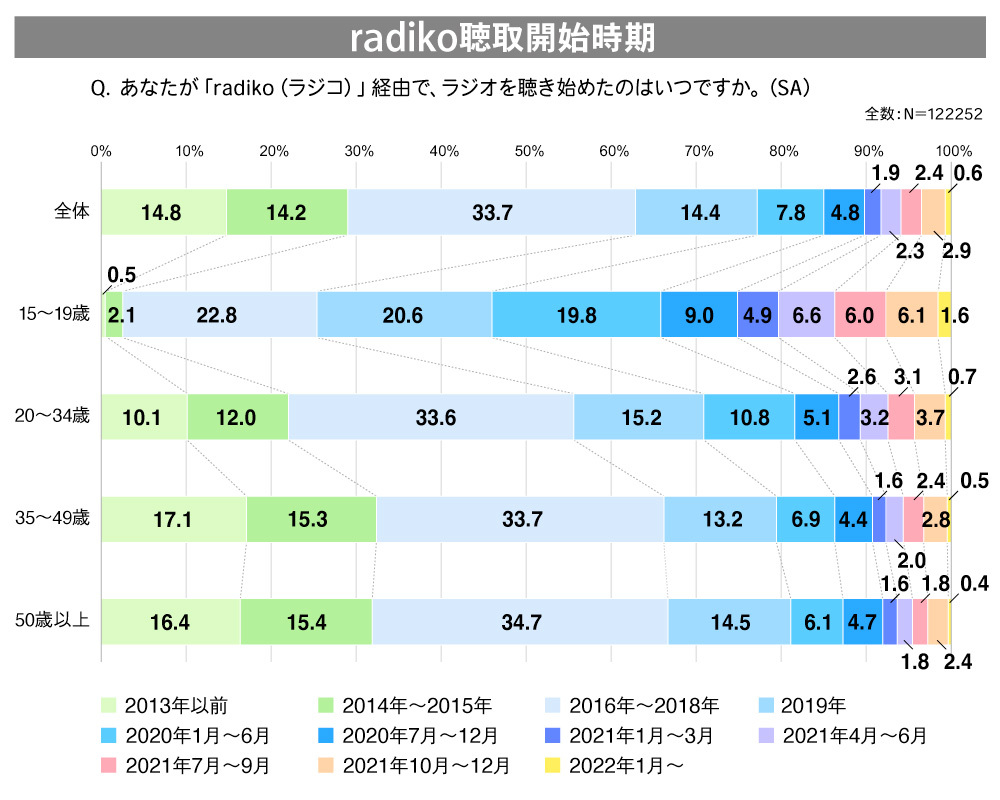
Koda: While radio usage is increasing, let's discuss the trends in usage scenarios—when users listen to radio or radiko.
Radio has always been a "background listening" medium, meaning many people use it while working, studying, doing housework, or other tasks. That's precisely why it was a good fit for the remote work and remote learning environments.
Surprisingly, many users also turn to it when they want to concentrate. According to a radiko news article, 80% of users play some kind of background music when they need to focus, and among those, slightly more tend to "play radio rather than music." User feedback includes comments like: "I can concentrate better while listening to people talk," "The familiar voices of the personalities help," "It lets me work calmly," and "The pace of the talk helps me get things done."
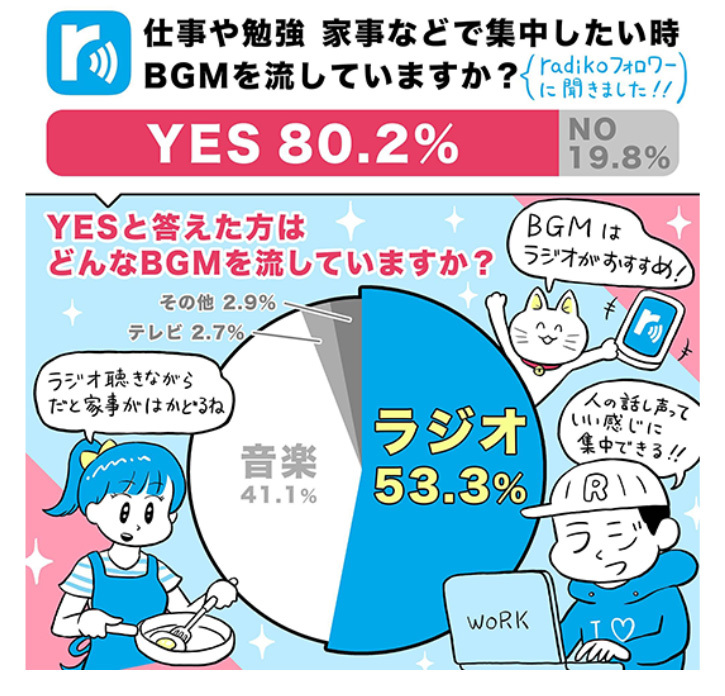 Source: radiko news (August 2021)
Source: radiko news (August 2021) Furthermore, a radiko user survey revealed that younger users, in particular, use radiko while gaming, which was surprising.
While social media is often considered a good match for radio, the survey also clearly shows that users in their teens and twenties overwhelmingly tend to listen while using social media services.
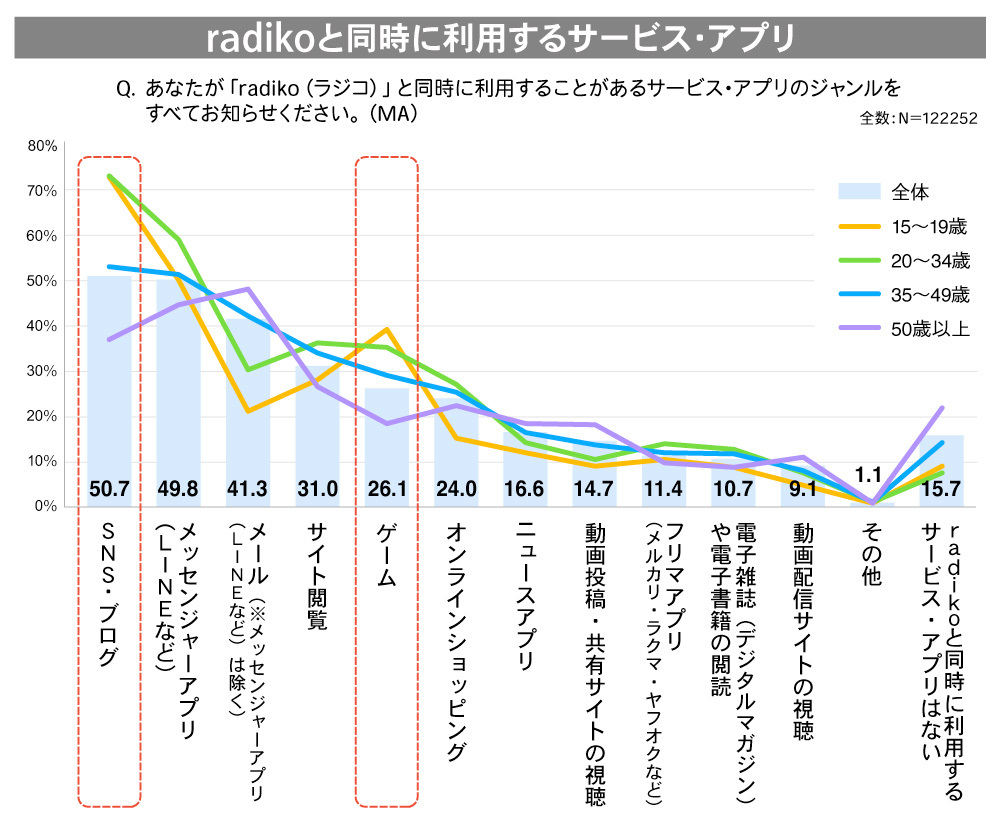
Another trend appears to be that many users listen not only while doing something else or concentrating on something, but also during relaxing time on holidays or while lying in bed before sleep.

Furthermore, even when used during multitasking, radiko demonstrates effectiveness in improving awareness, recall, and favorability of commercials heard through the service.
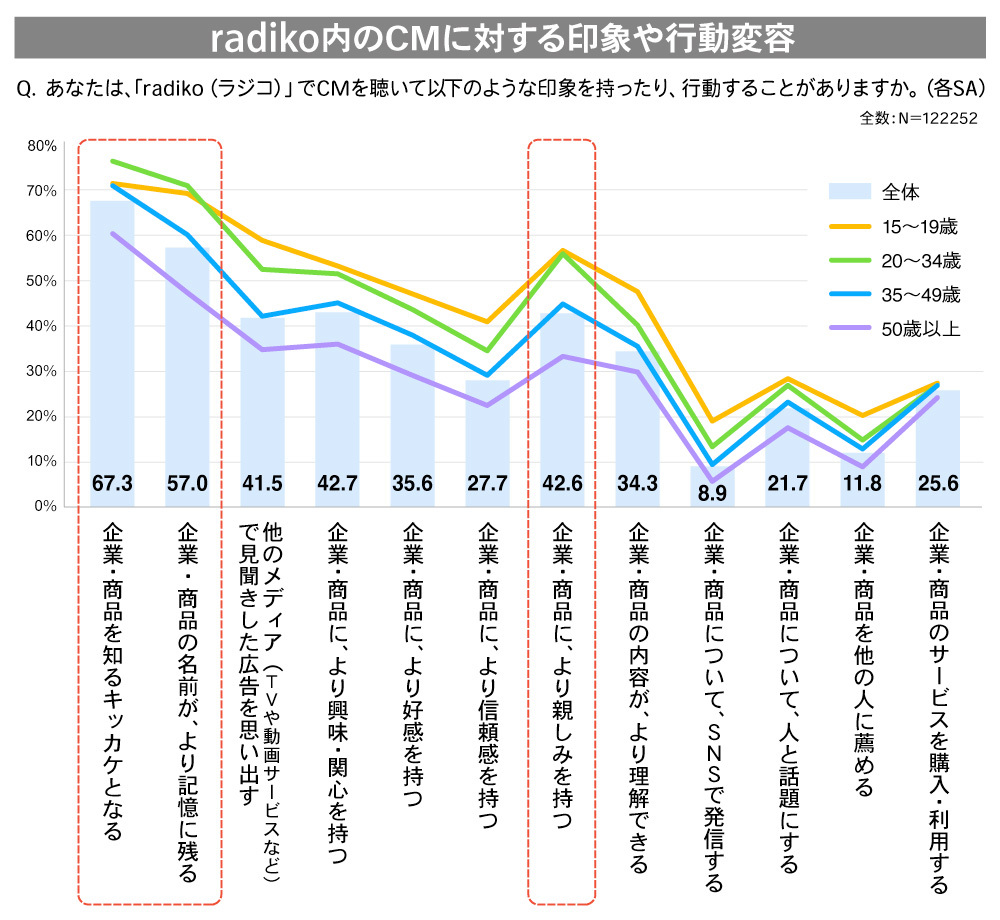
Survey results like these suggest...
- Radio doesn't interfere with tasks. It seems well-suited for both times when you want to concentrate and when you want to relax.
- Even when multitasking, listeners seem to absorb the content well and perceive the information positively.
These trends and characteristics emerged, but we wanted to dig deeper—is there a connection to the actual emotions of users listening to radiko (radio)?
Ogawa: That's why, with the cooperation of Dentsu ScienceJam Inc., we decided to investigate the impact radio has on people's emotions.
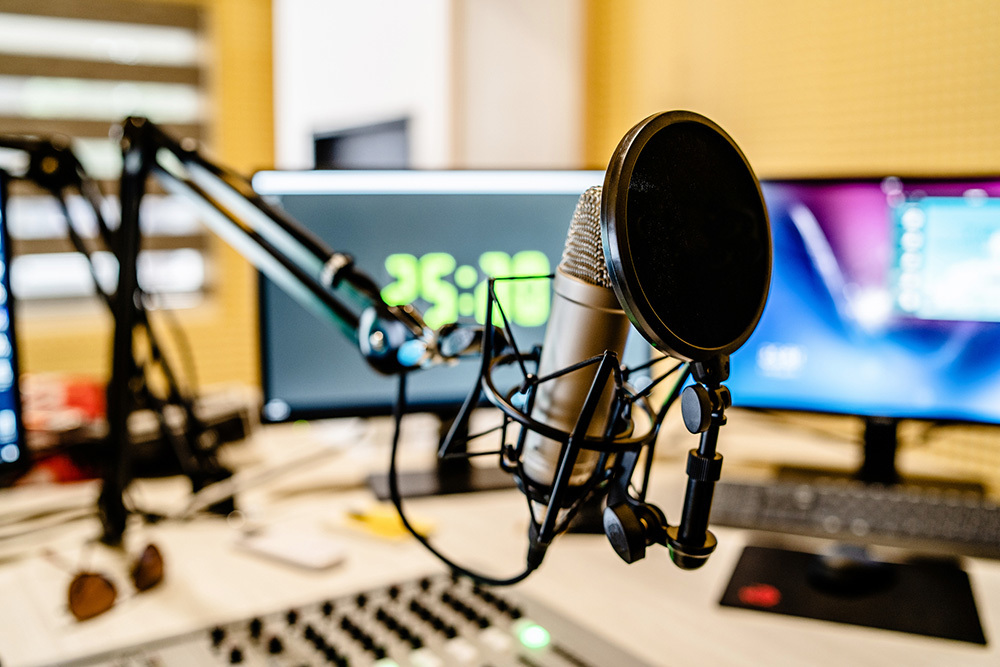
Visualizing Listener Emotions with EEG
Kibata: Yes. Kibata from CXCC again. I'll take it from here.
Until last year, I was seconded to Dentsu ScienceJam Inc., where I worked on visualizing people's feelings using brainwaves.
When designing customer experiences, I believe emotional design is essential across various touchpoints. Experiences that evoke emotion are said to be more memorable. What kind of scenes, media, and creative content are most effective at stirring emotions? Clarifying this question is crucial for creating richer customer experiences.
Therefore, this time we focused on "radio" and conducted an experiment using brainwave measurement (※4). How does "sound," radio's defining characteristic, affect listeners' emotions?
※4 Utilized an affective evaluation system employing "affect measurement technology via brainwave monitoring" owned by Dentsu ScienceJam Inc. Using a proprietary simplified EEG device enables real-time assessment of affect from brainwave data while subjects perform tasks.
Research Institution: Dentsu ScienceJam Inc.
Research Method: Quantitative research utilizing neuro-research
Survey Participants: 30 men and women in their 20s to 40s
Survey Date: June 24, 2021
[Question 1] Does listening to the radio really help you get work done?
radiko's survey also mentioned "being able to work calmly," but what's the actual situation?
Participants were asked to type on a PC in both a silent environment and while listening to the radio. The results showed that multitasking while listening resulted in lower stress levels and a more relaxed state. Although not statistically significant, concentration levels and excitement levels also appeared to be higher during multitasking.
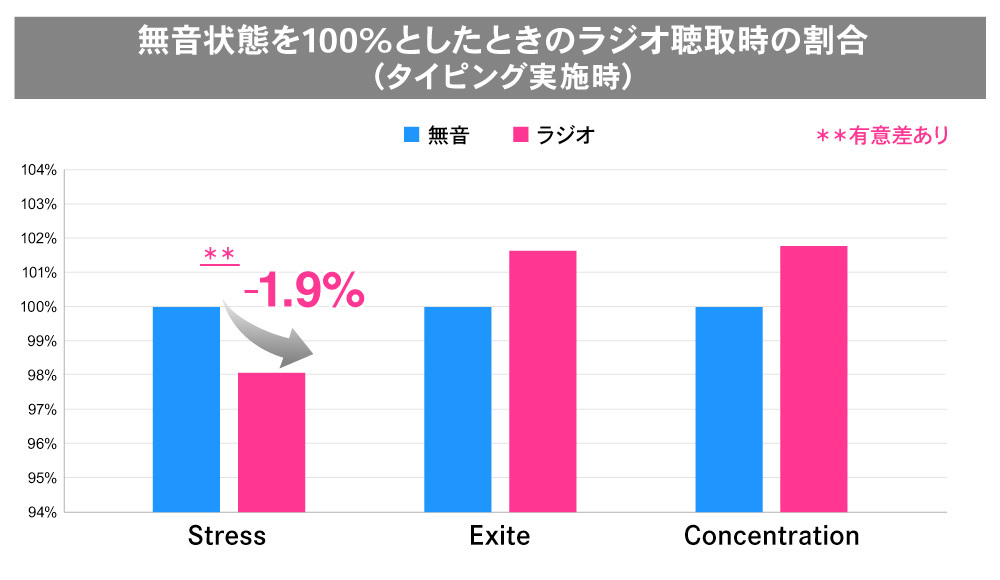
Looking at the typing results, mistakes were fewer when listening to the radio.
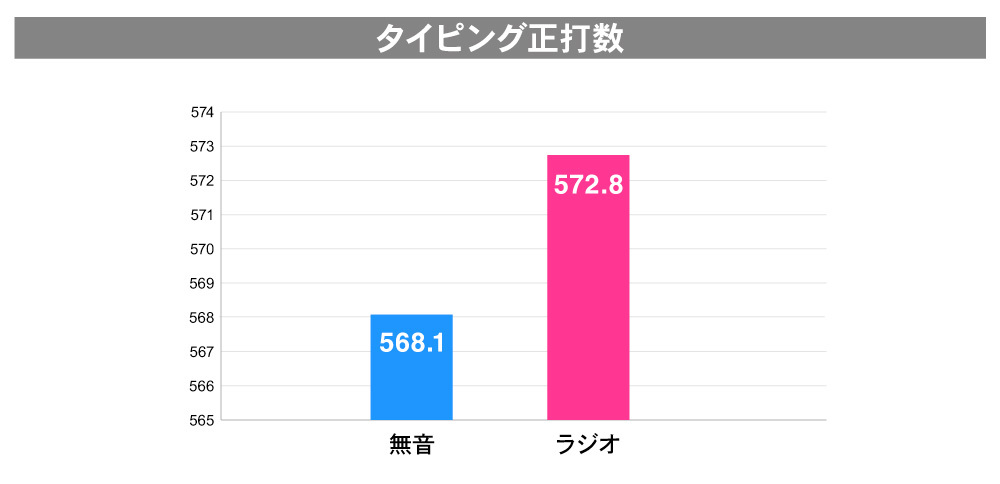
Similar to the survey results, it was confirmed that working while listening to the radio actually led to a more relaxed state and increased productivity. This time, participants performed simple tasks while listening to talk-focused radio programs. However, the type of program that allows for greater concentration likely varies depending on the nature of the work. We hope to investigate this further in future studies.
[Question 2] What are the benefits of radio commercials?
What effects can be observed when combining radio and TV commercials? Using commercials for several products as research material, we compared metrics between people exposed only to TV commercials, only to radio commercials, and to both.
We found that those exposed to both had higher levels of concentration and interest. While this could partly be due to increased exposure frequency, it suggests TV + radio may be more effective at sparking interest in the product. Additionally, favorability increased, indicating a potential contribution to branding. Rhythm-based commercials, which convey messages in sync with a beat, tend to boost favorability more easily and may be particularly suited for media mix campaigns.
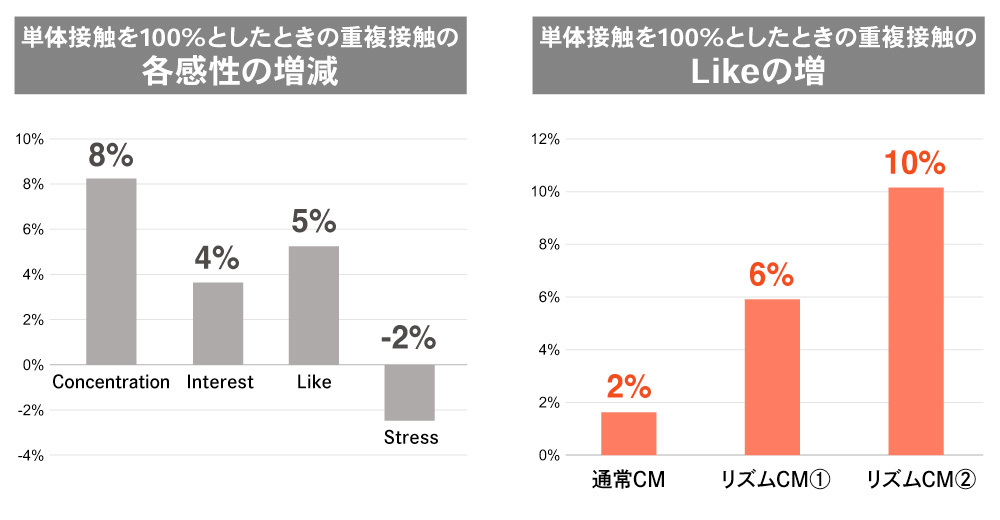
【Question 3】What kind of commercials stir emotions?
Among the commercials used in the survey, rhythm-based commercials showed a particular tendency to increase favorability. These are commercials featuring catchy jingles or repeated company names.
It seems logical that ads with a strong musical quality, appealing through sound, are more memorable and more likely to create a positive image.
Another interesting finding: Two commercials featured voice actors. One featured only male voice actors, while the other featured both male and female voice actors. In both cases, female participants showed higher favorability and stress levels compared to male participants.
Past research suggests that "stimulation is necessary for memorability, which can increase stress levels." For female listeners, commercials featuring distinctive voices like those of voice actors may be more memorable. While this study didn't explore the exact reasons, delving deeper into the relationship between voice quality, frequency, and perception seems promising.
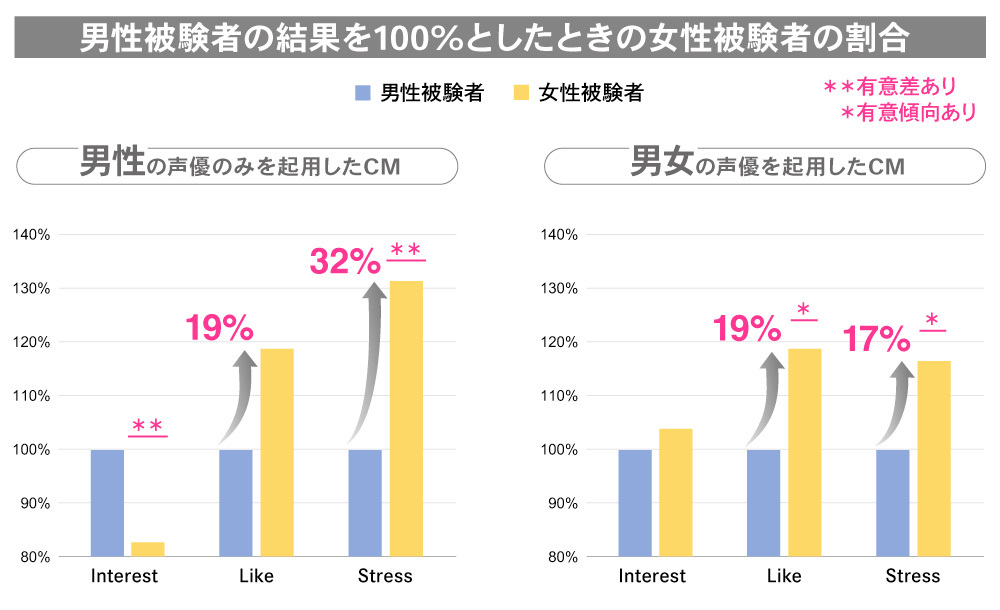
Emotional Experiences and Radio's Potential
Kihata: Based on these findings, I realized that even though we simply call it "sound," how it's conveyed, the timing, and who is speaking can significantly alter how listeners perceive it.
Koda: That's right. We found that female listeners showed higher favorability and stress levels toward voice actor voices compared to male listeners. It's fascinating that listeners' hearts are moved in some way, and these feelings genuinely manifest emotionally. Radio is a medium where the psychological distance between speaker and listener is close. That's why listeners feel like they're being spoken to personally, and each listener builds their own unique relationship with the personality. That's precisely why the emotions that arise differ, and how those emotions move changes based on the perceived relationship. When a personality speaks, some listeners might think, "Maybe I'll buy that," even if it's a bit pricey...
Kihata: They say live commercials actually sell products, right?
Koda: Getting people to buy things based solely on sound is pretty amazing, and I think it happens because the sound somehow affects the listener's emotions. This time, we saw something like a trigger for that, and I feel that if we can clarify that aspect further, we might be able to make the power of radio and the strengths of this bond-building medium a bit more visible.
Kihata: That's true. When you listen to radio with headphones, it feels like the speaker is physically right next to your ear, like the personality is right there. Maybe that brings you closer emotionally too.
Koda: In that sense, with the style of listening through headphones becoming increasingly widespread, I think it might also create new opportunities for sound.
Ogawa: Regarding the psychological distance between the personality and the listener, if we could conduct experiments like measuring how much the listener's emotions change between the voice of someone they regularly hear and the voice of a personality they're hearing for the first time, we might discover even more strengths of radio as an audio medium.
Kihata: Exactly. This time, we tried talking ourselves, and it was incredibly difficult...
Koda: Seriously, I really admire the personalities...
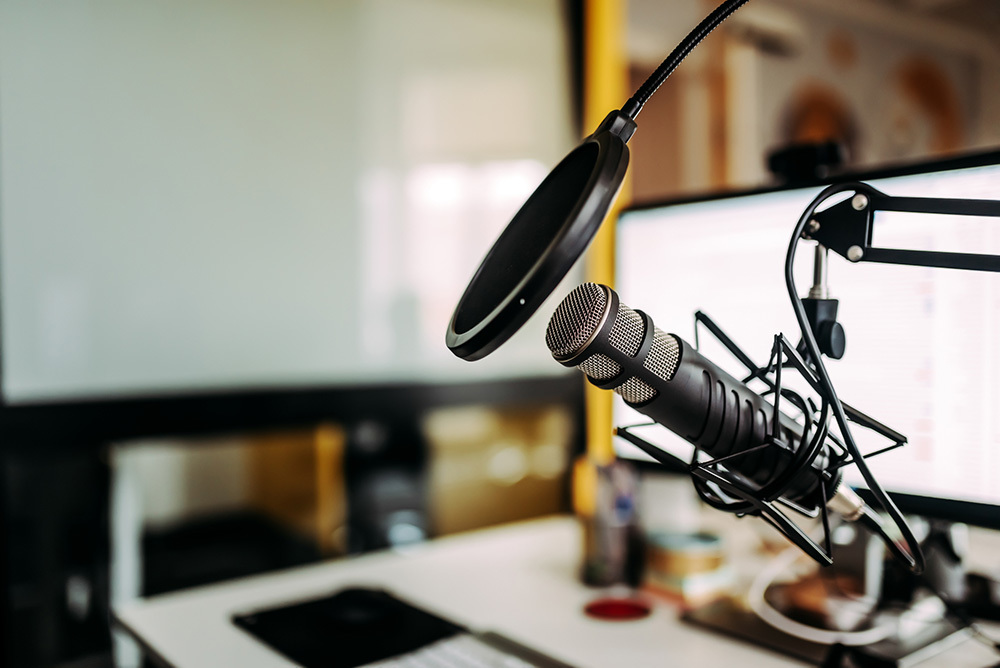
Ogawa: While we might think stress is a negative outcome, it was a valuable lesson to learn that stress is actually important for increasing favorability and making it memorable. Simply liking something isn't enough to make it stick in people's minds.
Kihata: Yes, in terms of stimulation.
Ogawa: Maybe wearing headphones itself provides that stimulus, or perhaps it connects to that "Like" feeling. We'd like to investigate that further in the future.
Kihata: I used to think radio listeners were mostly older folks, but as more young people start listening, I feel radio's potential expands if it can offer light, interactive communication like social media.
Ogawa: Since Generation Z also seems to be listening to audio more, I think we can expect great things going forward.
Koda: If we get another chance to research, it would be interesting to compare how emotional responses and perceptions of audio information differ between younger and older listeners.
Kihata: It would be fascinating to delve deeper into how to communicate effectively with your target audience and what emotions to evoke to build brand recognition.
Koda: There's still so much to uncover about the strengths of audio and radio from an emotional perspective.
Kihata: This radio-style Web Dentsu Inc. was a really enjoyable session.
Ogawa: I learned a lot.
Kibata: I really came to appreciate how amazing radio personalities are. I know there might have been some rough spots, but thank you to everyone who listened.
Was this article helpful?
Newsletter registration is here
We select and publish important news every day
For inquiries about this article
Author

Yoko Kibata
Dentsu Inc.
CXCC Dentsu Lab Tokyo
Producer
After serving at the OOH Division, the 9th Sales Division, and the 1CRP Division, he was seconded as a director to Dentsu ScienceJam Inc., which handles science business. He engaged in a wide range of duties including research, planning, product development, and various direction and production roles.

Satoshi Ogawa
Dentsu Inc.
Media Services / Radio,TV Division
After working at Media Services / Newspaper Division, Chubu Branch Office, and Digital Business Division, he moved from Media Services / Radio,TV Division TB4 to the Radio Media Development Department. He has been involved in various areas of audio advertising, including sales of audio ads, development of spot products, and research/analysis of audio advertising.
Articles by this person

Chihiro Koda
Dentsu Inc.
Media Services / Radio,TV Division
After working in digital media and radio at the Chubu Branch Office, I transferred to the Radio Media Development Department. Alongside Ogawa PC, I engaged in a wide range of activities within the audio advertising field, including sales of audio ads, research/analysis of audio advertising, and production of audio content such as podcasts.


